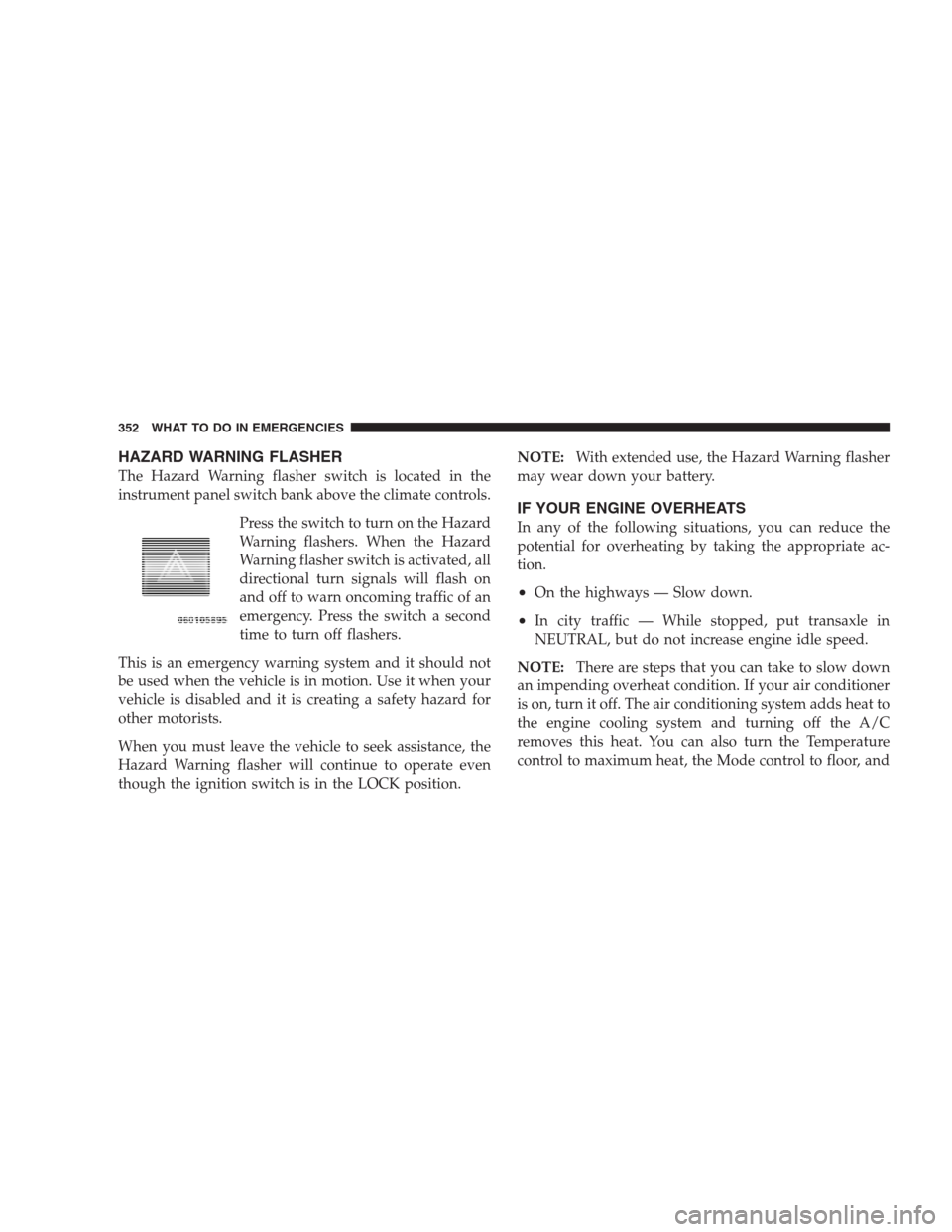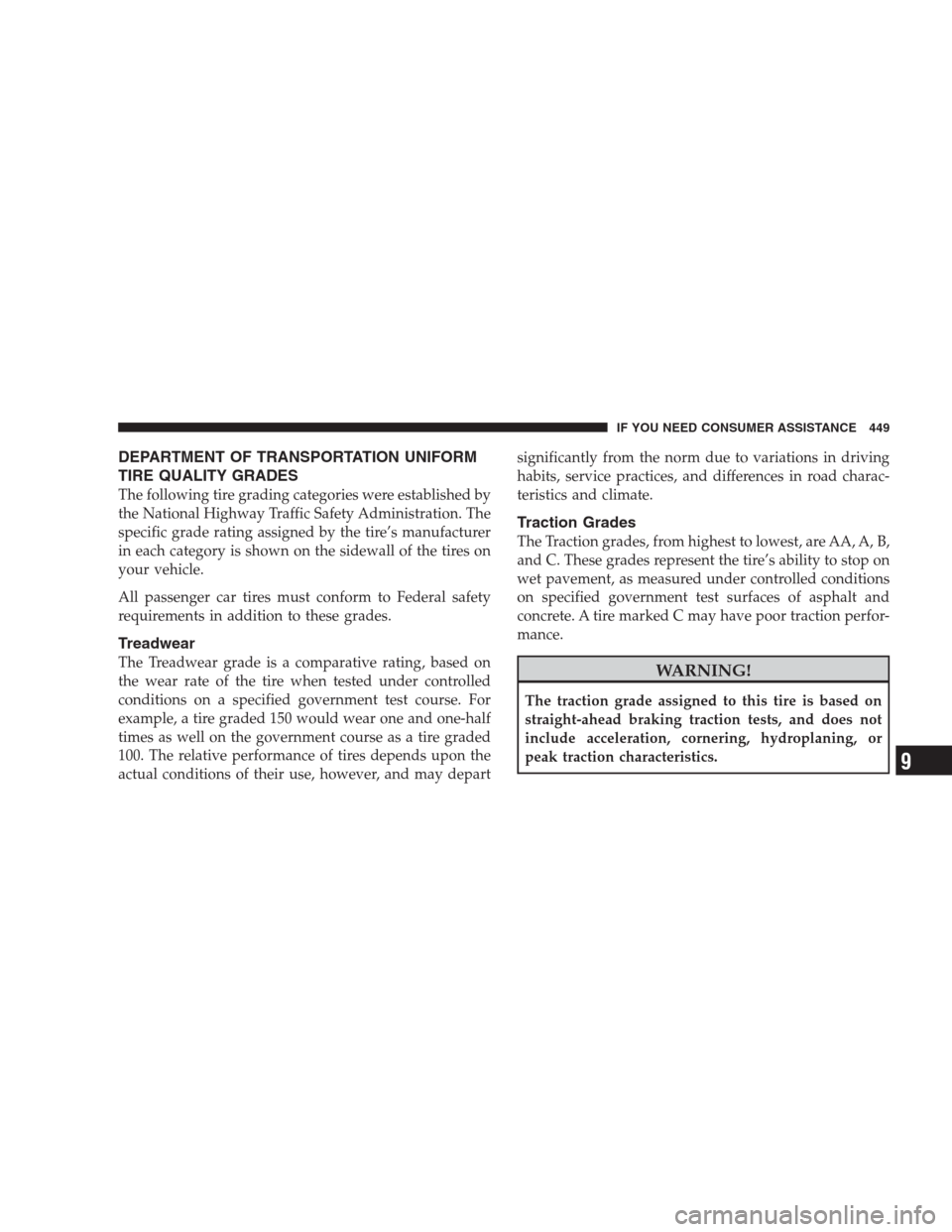Page 252 of 475

6. Do not expose the disc to direct sunlight.
7. Do not store the disc where temperatures may become
too high.
NOTE:If you experience difficulty in playing a particu-
lar disc, it may be damaged (i.e. scratched, reflective
coating removed, a hair, moisture or dew on the disc)
oversized, or have theft protection encoding. Try a
known good disc before considering disc player service.
RADIO OPERATION AND CELLULAR PHONES
Under certain conditions, the cellular phone being ON in
your vehicle can cause erratic or noisy performance from
your radio. This condition may be lessened or eliminated
by relocating the cellular phone antenna. This condition
is not harmful to the radio. If your radio performance
does not satisfactorily “clear” by the repositioning of the
antenna, it is recommended that the radio volume be
turned down or off during cellular phone operation.
CLIMATE CONTROLS
The Air Conditioning and Heating System is designed to
make you comfortable in all types of weather.
Manual Heating Ventilation and Air Conditioning
(HVAC)
The Manual Temperature Controls consist of a series of
outer rotary dials and inner push knobs.
250 UNDERSTANDING YOUR INSTRUMENT PANEL
Page 253 of 475

Blower Control
Rotate this control to regulate the
amount of air forced through the ven-
tilation system in any mode. The
blower speed increases as you move
the control to the right from the “O”
(OFF) position. There are four blower
speeds.
NOTE:For vehicles equipped with Remote Start, the
climate controls will not function during Remote Start
operation if the blower control is left in the “O” (Off)
position.
Temperature Control
Rotate this control to regulate the tem-
perature of the air inside the passenger
compartment. Rotating the dial left
into the blue area of the scale indicates
cooler temperatures while the rotating
right into the red area indicates
warmer temperatures.
NOTE:If your air conditioning performance seems
lower than expected, check the front of the A/C con-
denser located in front of the radiator for an accumula-
tion of dirt or insects. Clean with a gentle water spray
from behind the radiator and through the condenser.
Fabric front fascia protectors may reduce airflow to the
condenser, reducing air conditioning performance.
UNDERSTANDING YOUR INSTRUMENT PANEL 251
4
Page 257 of 475

Automatic Operation
The Infrared Climate Control System automatically
maintains the climate in the cabin of the vehicle at the
comfort levels desired by the driver and passenger. To
accomplish this, the system gathers information from the
cabin infrared sensor mounted between the sun-visors
and from various sensors located throughout the vehicle.
The controls on the climate control provide the system
with operator input. Other sensors take account of ve-
hicle speed, A/C pressure, outside temperature, and
engine cooling temperature. Using all of these inputs, the
system automatically adjusts airflow temperature, air-
flow distribution, airflow volume, and the amount of
outside air recirculation. This maintains a comfortable
temperature even under changing conditions.
Operation of the system is quite simple.
1. Turn the Mode Control knob (on the right) and the
Blower Control knob (on the left) to AUTO.NOTE:The AUTO position performs best for front seat
occupants only.
2. Dial in the temperature you would
like the system to maintain by rotating
the Temperature Control knob. Once
the comfort level is selected, the sys-
tem will maintain that level automati-
cally using the heating system. Should
the desired comfort level require air
conditioning, the system will automatically make the
adjustment.
You will experience the greatest efficiency by simply
allowing the system to function automatically. Selecting
the “O” (OFF) position on the blower control stops the
system completely and closes the outside air intake.
72°F (22°C) is the recommended setting for maximum
comfort for the average person; however, this may vary.
UNDERSTANDING YOUR INSTRUMENT PANEL 255
4
Page 354 of 475

HAZARD WARNING FLASHER
The Hazard Warning flasher switch is located in the
instrument panel switch bank above the climate controls.
Press the switch to turn on the Hazard
Warning flashers. When the Hazard
Warning flasher switch is activated, all
directional turn signals will flash on
and off to warn oncoming traffic of an
emergency. Press the switch a second
time to turn off flashers.
This is an emergency warning system and it should not
be used when the vehicle is in motion. Use it when your
vehicle is disabled and it is creating a safety hazard for
other motorists.
When you must leave the vehicle to seek assistance, the
Hazard Warning flasher will continue to operate even
though the ignition switch is in the LOCK position.NOTE:With extended use, the Hazard Warning flasher
may wear down your battery.
IF YOUR ENGINE OVERHEATS
In any of the following situations, you can reduce the
potential for overheating by taking the appropriate ac-
tion.
•On the highways — Slow down.
•In city traffic — While stopped, put transaxle in
NEUTRAL, but do not increase engine idle speed.
NOTE:There are steps that you can take to slow down
an impending overheat condition. If your air conditioner
is on, turn it off. The air conditioning system adds heat to
the engine cooling system and turning off the A/C
removes this heat. You can also turn the Temperature
control to maximum heat, the Mode control to floor, and
352 WHAT TO DO IN EMERGENCIES
Page 408 of 475
CavityCartridge
FuseMini
FuseDescription
140 Amp
Green—Power Top Mod-
ule (If Equipped)
2—20 Amp
YellowAWD Module
CavityCartridge
FuseMini
FuseDescription
3—10 Amp
RedBattery Feed —
Center High
Mounted Stop
Light (CHMSL)/
Brake Switch
4—10 Amp
RedBattery Feed —
Ignition Switch
5—20 Amp
YellowTrailer Tow — If
Equipped
6—10 Amp
RedIgnition Off
Draw (IOD) —
Power Mirror
Switch/Climate
Controls
7—30 Amp
GreenIgnition Off
Draw (IOD)
Sense 1
Totally Integrated Power Module (TIPM)
406 MAINTAINING YOUR VEHICLE
Page 410 of 475
CavityCartridge
FuseMini
FuseDescription
17 —10 Amp
RedIgnition Off
Draw (IOD) —
Wireless Control
Module (WCM)/
Clock/Steering
Control Module
(SCM)
1840 Amp
Green—Battery Feed —
Auto Shutdown
(ASD) Relay
19 —20 Amp
YellowIgnition Off
Draw (IOD) —
Power Amp Feed
2 - if equipped
20 —15 Amp
Lt.
BlueIgnition Off
Draw (IOD) —
RadioCavityCartridge
FuseMini
FuseDescription
21 —10 Amp
Red—
22 —10 Amp
RedIgnition Run —
Climate
Controls/Hot
Cupholder - if
equipped
23 —15 Amp
Lt.
BlueAuto Shutdown
(ASD) Relay Feed
3
24 —25 Amp
ClearBattery Feed —
PWR Sunroof
Feed
25 —10 Amp
RedIgnition Run —
Heated Mirrors -
If Equipped
408 MAINTAINING YOUR VEHICLE
Page 451 of 475

DEPARTMENT OF TRANSPORTATION UNIFORM
TIRE QUALITY GRADES
The following tire grading categories were established by
the National Highway Traffic Safety Administration. The
specific grade rating assigned by the tire’s manufacturer
in each category is shown on the sidewall of the tires on
your vehicle.
All passenger car tires must conform to Federal safety
requirements in addition to these grades.
Treadwear
The Treadwear grade is a comparative rating, based on
the wear rate of the tire when tested under controlled
conditions on a specified government test course. For
example, a tire graded 150 would wear one and one-half
times as well on the government course as a tire graded
100. The relative performance of tires depends upon the
actual conditions of their use, however, and may departsignificantly from the norm due to variations in driving
habits, service practices, and differences in road charac-
teristics and climate.
Traction Grades
The Traction grades, from highest to lowest, are AA, A, B,
and C. These grades represent the tire’s ability to stop on
wet pavement, as measured under controlled conditions
on specified government test surfaces of asphalt and
concrete. A tire marked C may have poor traction perfor-
mance.
WARNING!
The traction grade assigned to this tire is based on
straight-ahead braking traction tests, and does not
include acceleration, cornering, hydroplaning, or
peak traction characteristics.
IF YOU NEED CONSUMER ASSISTANCE 449
9
Page 456 of 475

Calibration, Compass..................... 198
Capacities, Fluid........................ 420
Caps, Filler
Fuel................................ 334
Oil (Engine)..................369,370,371,378
Power Steering........................ 282
Radiator (Coolant Pressure)............... 391
Car Washes............................ 398
Carbon Monoxide Warning...............74,330
Cargo (Vehicle Loading)................... 337
Cellular Phone.......................102,250
Center High Mounted Stop Light............ 419
Certification Label....................... 337
Chains, Tire............................ 315
Changing A Flat Tire..................... 354
Chart, Tire Sizing........................ 299
Check Engine Light
(Malfunction Indicator Light)............... 373
Checking Your Vehicle For Safety............. 73Checks, Safety........................... 73
Child Restraint..................62,63,64,68,69
Child Restraint Tether Anchors.............66,68
Cigar Lighter........................... 167
Clean Air Gasoline....................... 327
Cleaning
Wheels............................. 400
Windshield Wiper Blades................. 385
Climate Control......................... 250
Clock.....................202,205,219,223,232
Coin Holder........................... 170
Compact Disc (CD) Maintenance............. 249
Compact Spare Tire...................... 310
Compass.............................. 198
Compass Calibration..................... 198
Compass Variance....................... 199
Computer, Trip/Travel.................... 196
Console, Floor.......................... 170
Contract, Service........................ 445
454 INDEX